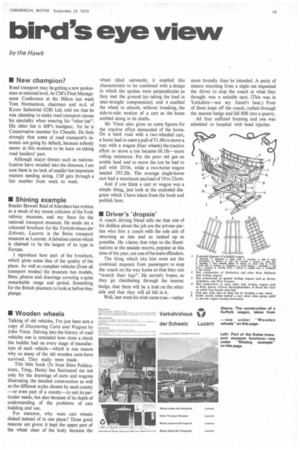bird's eye view
Page 81

If you've noticed an error in this article please click here to report it so we can fix it.
by the Hawk • New champion?
Road transport may be getting a new spokesman at national level. At CM's Fleet Management Conference at the Hilton last week Tom Normanton, chairman and m.d. of Kysor Industrial (GB) Ltd, told me that he was planning to make road transport causes his speciality when wearing his "other hat". His other hat is MP's headgear, for he is Conservative member for Cheadle. He feels strongly that some of road transport's interests are going by default, because nobody seems at this moment to be keen on taking road hauliers' part.
Although major threats such as nationalization have receded into the distance, I am sure there is no lack of smaller but important matters needing airing. CM gets through a fair number from week to week.
• Shining example
Reader Stewart Reid of Aberdeen has written as a result of my recent criticism of the York railway museum, and my fears for the national transport museum. He sends me a coloured brochure for the Verkehrshaus der Schweiz. Luzern; ie the Swiss transport museum at Lucerne, A fabulous centre which is claimed to be the largest of its type in Europe.
I reproduce here part of the brochure, which gives some idea of the quality of the place. As well as complete vehicles (from all transport modes) the museum has models, films, photos and drawings covering a quite remarkable range and period. Something for the British planners to look at before they plunge.
• Wooden wheels
Talking of old vehicles, I've just been sent a copy of Discovering Carts and Wagons by John Vince. Delving into the history of road vehicles one is reminded how close a check the builder had on every stage of manufacture of each vehicle—which is one reason why so many of the old wooden carts have survived. They really were made.
This little book (5s from Shire Publications, Tring, Herts) has fascinated me not only for the drawings of carts and wagons illustrating the detailed construction as well as the different styles chosen by each county —or even part of a county—to suit its particular needs, but also because of its depth of understanding of the problems of cart building and use.
For instance, why were cart wheels dished instead of in one plane? Three good reasons are given: it kept the upper part of the wheel clear of the body because the wheel tilted outwards; it enabled this characteristic to be combined with a design in which the spokes were perpendicular as they met the ground (so taking the load in near-straight compression); and it enabled the wheel to absorb, without breaking, the side-to-side motion of a cart as the horse ambled along in its shafts.
Mr Vince also gives us some figures for the tractive effort demanded of the horse. On a hard road with a two-wheeled cart, a horse had to emit a pull of 51.41b to move a ton; with a wagon (four wheels) the tractive effort to move a ton became 68.11b—more rolling resistance. Put the poor old gee on arable land and to move the ton he had to pull with 2011b, while a two-horse wagon needed 295.21b. The average single-horse cart had a maximum payload of 18 to 22cwt.
And if you think a cart or wagon was a simple thing, just look at the exploded diagram which I have taken from the book and publish here.
• Driver's idropsie'
A coach driving friend tells me that one of his dislikes about the job are the private parties who hire a coach with the sole aim of returning as late and as tanked up as possible. He claims that trips to the illuminations at the seaside resorts, popular at this time of the year, are one ofthe main offenders.
The thing which irks him most are the continual requests from passengers to stop the coach on the way home so that they can "stretch their legs". He secretly hopes, as they go clambering through the nearest hedge, that there will be a hole on the other side and that they will all fall in it.
Well, last week his wish came true—rather more brutally than he intended. A party of miners returning from a night out requested the driver to stop the coach at what they thought was a suitable spot. (This was in Yorkshire—not my friend's beat.) Four of them leapt off the coach, rushed through the nearest hedge and fell 80ft into a quarry.
All four suffered bruising and one was admitted to hospital with head injuries.


























































































































































































